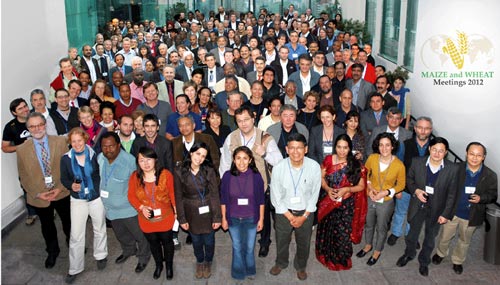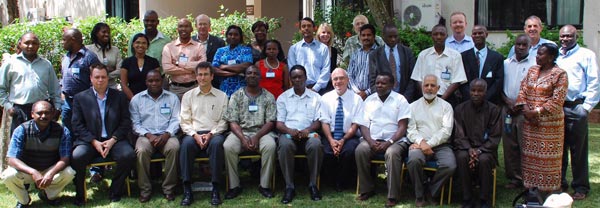The race is on to replace existing varieties amid concerns that climate change is likely to intensify droughts and significantly depress maize harvests in sub-Saharan Africa.
As climate change intensifies drought conditions in Africa and sparks fears of a new cycle of crippling food shortages, a study released today finds widespread adoption of recently developed drought-tolerant varieties of maize could boost harvests in 13 African countries by 10 to 34 percent and generate up to US$1.5 billion in benefits for producers and consumers.
“We need to move deliberately, but with urgency, to get these new varieties from the breeders to the farmers, because their potential to avert crises is considerable,” said Roberto La Rovere, a socio-economist at the International Maize and Wheat Improvement Center (known by its Spanish acronym CIMMYT) and lead author of the study, which was produced in partnership with the International Institute of Tropical Agriculture (IITA).
“Our analysis shows that with high rates of adoption, more than four million producers and consumers would see their poverty level drop significantly by 2016,” he added.
The study was conducted as part of the Drought Tolerant Maize for Africa Initiative (DTMA) implemented by CIMMYT and IITA with funding from the Bill & Melinda Gates Foundation and the Howard G. Buffett Foundation. CIMMYT and IITA have worked with national agriculture research centers in Africa to develop over 50 new maize varieties that in drought conditions can produce yields that are 20 to 50 percent higher than existing varieties.
The CIMMYT-IITA analysis of the benefits of conventional drought-tolerant maize for Africa, or DTMA, examined the potential impact in Angola, Benin, Ethiopia, Ghana, Kenya, Malawi, Mali, Mozambique, Nigeria, Tanzania, Uganda, Zambia and Zimbabwe. The researchers found that under “conservative yield” improvements, the new varieties would provide farmers and consumers with food and income worth US$537 million, while under more “optimistic yield improvements,” their value would increase to US$876 million.
Moreover, the researchers estimate that if drought-tolerant maize completely replaced existing varieties in the countries studied, the benefits could reach US$1.5 billion.
Farmers and consumers in Kenya, Malawi, Zambia, and Zimbabwe would see the greatest benefits, the authors note, because maize dominates local diets and livelihoods, and farmers in these countries have a history of rapidly adopting improved maize varieties.
“The goal now is to make drought-tolerant maize easily available to millions of smallholder growers in countries where droughts, which always lurk as a perennial threat to food production, are expected to become more common and more severe,” said Hartmann, director general of IITA. “Maize is life for 300 million in Africa, and as climatic conditions deteriorate, it is up to researchers in cooperation with governments, seed companies and farmers to ensure that maize production does not collapse.”
For example, a peer-reviewed study published last year by Stanford University and the Global Crop Diversity Trust warned that by 2050, growing conditions in most African countries will be hotter than any year on record and that many varieties of maize now under cultivation will no longer be viable. Another study from the International Livestock Research Institute (ILRI) warned that a failure to transition to drought-tolerant maize could diminish yields across the region by up to one ton per hectare.
Some of the new drought-tolerant maize seed is already reaching farmers’ fields. This year alone, four new varieties developed by breeders with IITA and the Government of Ghana that are both drought-tolerant and resistant to the parasitic weed Striga were officially released.
The CIMMYT-IITA study examined past trends in adoption of improved maize varieties and cautioned that there could be wide variations in the rate at which farmers’ transition to drought-tolerant maize. For example, adoption rates are projected to be as high as 85 percent in Kenya and Zambia, but only 20 percent in Benin, 30 percent in Mali, and 27 percent in Mozambique.
“It is very important for everyone at all points in the value chain to coordinate their efforts so that we address the challenges that in the past have made it very difficult for many African farmers to obtain seed of improved crop varieties,” said Wilfred Mwangi, associate director of CIMMYT’s global maize program and leader of the DTMA project.
According to Mwangi, farmers will adopt a new crop variety if it offers distinct advantages. But they still face barriers to obtaining improved seeds.
“Over the years, many farmers in sub-Saharan Africa have continued to grow old, low-yielding, and unsuitable maize varieties, despite the availability of newer and better-performing ones,” said Mwangi. “This is partly because they don’t know about the new varieties or can’t get credit to buy seed. Many farmers are discouraged from buying seed because they can’t sell their surplus grain at attractive prices; others live beyond the reach of commercial seed companies.”
Feeding farm families in dry areas of Malawi
In Malawi, the impact of the DTMA project is already becoming evident in farmers’ fields and finances. For example, Bamusi Stambuli estimated he will save US$330 over 12 months by growing a drought-tolerant maize variety developed by CIMMYT and breeders from Malawi’s Chitedze Research Station. This year, Stambuli’s maize yields of this variety were nearly twice those of other popular local varieties. “I will now be able to feed my family for 12 months,” said Stambuli, who has seven children and five grandchildren.
“The climate is changing, rainfall is decreasing, and the weather is now dictating which varieties farmers grow and in turn what varieties seed companies produce,” said Dellings Phiri, Managing Director of Seed Co. Malawi, a leading seed company in the southern African region.
Two varieties released in Malawi in 2009—ZM 309 and ZM 523—are suited specifically for drought-prone areas where soils are infertile. Introduced by local extension agents to farmers in the Balaka area, the new varieties have produced good yields in demonstration plots. Farmers are saying that ZM 309 and ZM 523 yield more corn, mature earlier, and are better for pounding into flour than other popular commercial varieties.
Locally, ZM 523 is known as “Mwayi”—the Chichewa term for “fortunate.” ZM 309 is called “Msunga banja,” or “that which takes care of or feeds the family.” In September 2009, the Malawi government decided to include ZM 309 in a government initiative that offers farmers discounts on purchases of improved maize seeds.
Related stories
Study says drought tolerant maize will greatly profit African farmers
Maize farmers and seed businesses changing with the times in Malawi
Drought: Grim Reaper of harvests and lives
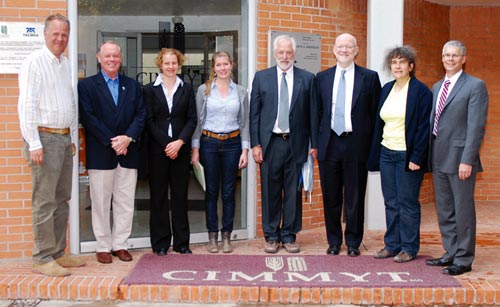 Senior management and center scientists welcomed Chris Elias, the new President of Global Development of the Bill & Melinda Gates Foundation, to CIMMYT headquarters on 30 March 2012, providing among other things an introduction to major programs. Elias’ background includes experience in the global non-profit health sector and most recently as CEO of PATH, a nongovernmental organization whose portfolio includes solutions for AIDS, tuberculosis, and malaria. David Bergvinson, Senior Program Officer for Science & Technology, for the Foundation accompanied Elias to CIMMYT.
Senior management and center scientists welcomed Chris Elias, the new President of Global Development of the Bill & Melinda Gates Foundation, to CIMMYT headquarters on 30 March 2012, providing among other things an introduction to major programs. Elias’ background includes experience in the global non-profit health sector and most recently as CEO of PATH, a nongovernmental organization whose portfolio includes solutions for AIDS, tuberculosis, and malaria. David Bergvinson, Senior Program Officer for Science & Technology, for the Foundation accompanied Elias to CIMMYT.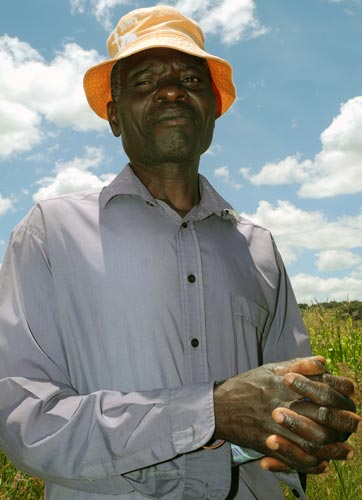 Tunga Silvar grows maize to feed his wife and fourgrandchildren on about 0.5 hectares of land in Mawanga, Zimbabwe, a hilly area some 45 kilometers northeast of Harare. Like otherfarmers in the region, he is acutely aware of the value of nitrogen fertilizer, continually juggles his limited household financesto get it, and is poorer and hungrier when he can’t. “We used to sell maize, but in the last five years we haven’t been able to do so,” saysSilvar. “I had to pay school fees for my grandchildren, so I couldn’t buy fertilizer. Fertilizer is very important, especially in our type of soil. If you don’t apply it, youcan barely harvest anything.”
Tunga Silvar grows maize to feed his wife and fourgrandchildren on about 0.5 hectares of land in Mawanga, Zimbabwe, a hilly area some 45 kilometers northeast of Harare. Like otherfarmers in the region, he is acutely aware of the value of nitrogen fertilizer, continually juggles his limited household financesto get it, and is poorer and hungrier when he can’t. “We used to sell maize, but in the last five years we haven’t been able to do so,” saysSilvar. “I had to pay school fees for my grandchildren, so I couldn’t buy fertilizer. Fertilizer is very important, especially in our type of soil. If you don’t apply it, youcan barely harvest anything.”
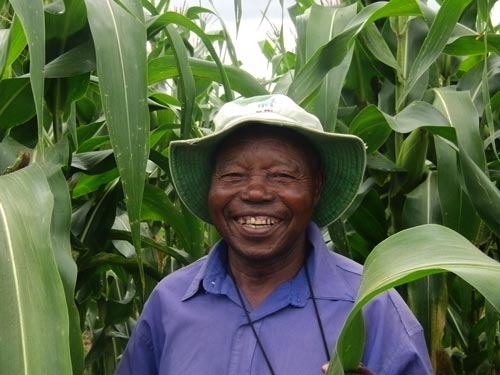 Late and erratic rainfall in Zimbabwe has many farmers facing the prospect of poor harvests. The current hardships from drought though may furnish some hopefor farmers. New drought tolerant varieties are being tested in on-farm trials under farmer management. Many of the trials are experiencing drought stress—aperfect opportunity to identify the best varieties for such harsh conditions. A recent visit to on-farm trials in the Murewa District of Zimbabwe showed many new drought tolerant products performing well. Local farmer Sailas Ruswa is growing a trial and was enthusiastic about what he saw: some varieties showedsigns of severe drought stress, but a few were holding up well and were expected to produce good yields.
Late and erratic rainfall in Zimbabwe has many farmers facing the prospect of poor harvests. The current hardships from drought though may furnish some hopefor farmers. New drought tolerant varieties are being tested in on-farm trials under farmer management. Many of the trials are experiencing drought stress—aperfect opportunity to identify the best varieties for such harsh conditions. A recent visit to on-farm trials in the Murewa District of Zimbabwe showed many new drought tolerant products performing well. Local farmer Sailas Ruswa is growing a trial and was enthusiastic about what he saw: some varieties showedsigns of severe drought stress, but a few were holding up well and were expected to produce good yields.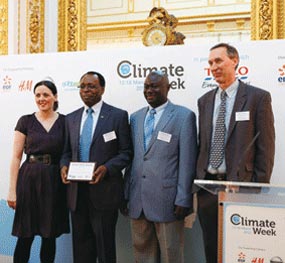 DTMA has been responsible for the development and dissemination of 34 new drought-tolerant maize varieties to farmers in 13 project countries—Angola, Benin, Ethiopia, Ghana, Kenya, Malawi, Mali, Mozambique, Nigeria, Tanzania, Uganda, Zambia, and Zimbabwe—between 2007 and 2011. An estimated two million smallholder farmers are already using the drought-tolerant maize varieties and have obtained higher yields, improved food security, and increased incomes.
DTMA has been responsible for the development and dissemination of 34 new drought-tolerant maize varieties to farmers in 13 project countries—Angola, Benin, Ethiopia, Ghana, Kenya, Malawi, Mali, Mozambique, Nigeria, Tanzania, Uganda, Zambia, and Zimbabwe—between 2007 and 2011. An estimated two million smallholder farmers are already using the drought-tolerant maize varieties and have obtained higher yields, improved food security, and increased incomes.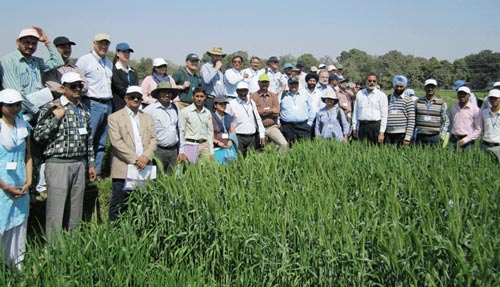 Meeting was held in the Indian holy city of Varanasi during 27 February to 01 March 2012. It was organized jointly by Banaras Hindu University (BHU), HarvestPlus, and CIMMYT to discuss wheat biofortification research outputs and future plans. The meeting was attended by about 40 scientists, including Hans Braun, Ravi Singh, Kevin Pixley, Velu Govindan, Etienne Duveiller, Arun Joshi, and Iván Ortiz-Monasterio from CIMMYT, along with participants from the Bill & Melinda Gates Foundation, HarvestPlus, the Indian national agricultural research system, the private sector, and more than 200 farmers from the eastern part of the state of Uttar Pradesh.
Meeting was held in the Indian holy city of Varanasi during 27 February to 01 March 2012. It was organized jointly by Banaras Hindu University (BHU), HarvestPlus, and CIMMYT to discuss wheat biofortification research outputs and future plans. The meeting was attended by about 40 scientists, including Hans Braun, Ravi Singh, Kevin Pixley, Velu Govindan, Etienne Duveiller, Arun Joshi, and Iván Ortiz-Monasterio from CIMMYT, along with participants from the Bill & Melinda Gates Foundation, HarvestPlus, the Indian national agricultural research system, the private sector, and more than 200 farmers from the eastern part of the state of Uttar Pradesh.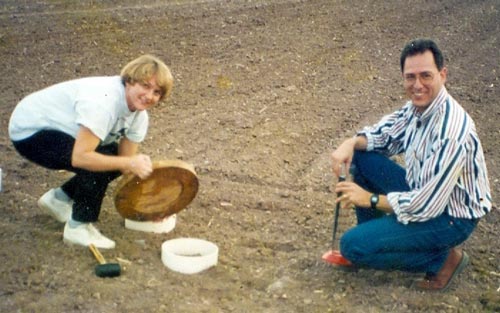 The Yaqui Valley is one of Mexico’s main bread baskets and supplies seeds and grain globally. It was the birthplace of the Green Revolution and, as the home of CIMMYT’s primary field station, Campo Experimental Norman E. Borlaug (CENEB), it has been a hub of agronomic research for decades, with a wealth of accumulated knowledge, field research, and survey data. However, the region is not without its problems. It faces environmental, resource, economic, and social challenges related to water resources, air and water pollution, policy changes, human health concerns, biodiversity conservation, and climate change.
The Yaqui Valley is one of Mexico’s main bread baskets and supplies seeds and grain globally. It was the birthplace of the Green Revolution and, as the home of CIMMYT’s primary field station, Campo Experimental Norman E. Borlaug (CENEB), it has been a hub of agronomic research for decades, with a wealth of accumulated knowledge, field research, and survey data. However, the region is not without its problems. It faces environmental, resource, economic, and social challenges related to water resources, air and water pollution, policy changes, human health concerns, biodiversity conservation, and climate change.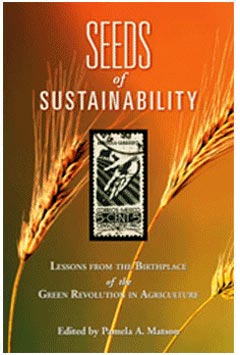 Seeds of Sustainability is the product of these 15 years of research, analysis, and evaluation in the Yaqui Valley. Edited by renowned scientist and Dean of the
Seeds of Sustainability is the product of these 15 years of research, analysis, and evaluation in the Yaqui Valley. Edited by renowned scientist and Dean of the 